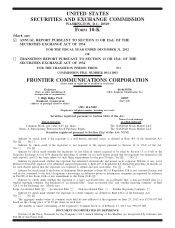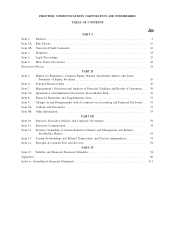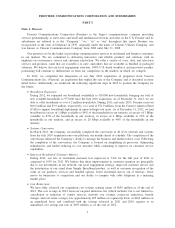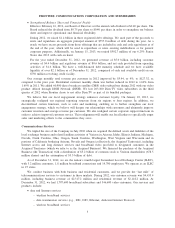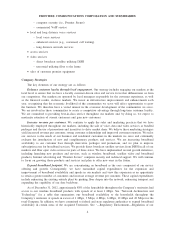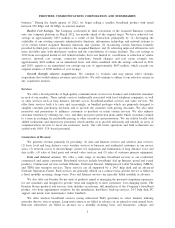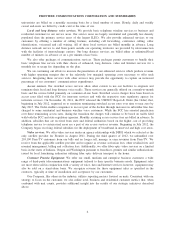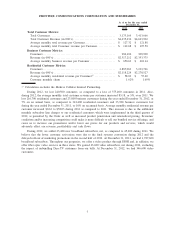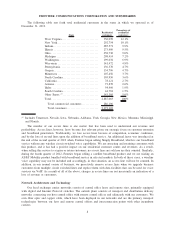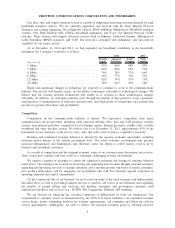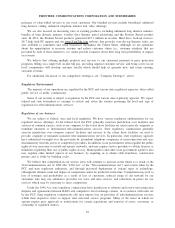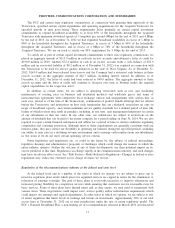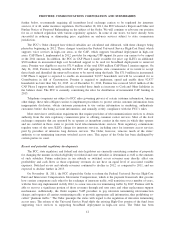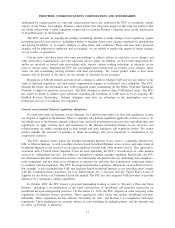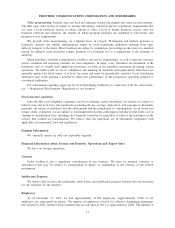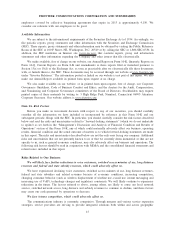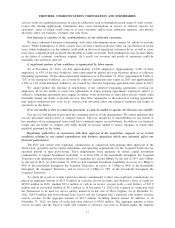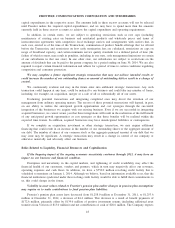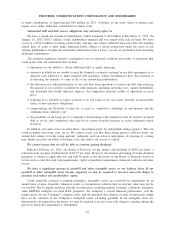Frontier Communications 2012 Annual Report Download - page 10
Download and view the complete annual report
Please find page 10 of the 2012 Frontier Communications annual report below. You can navigate through the pages in the report by either clicking on the pages listed below, or by using the keyword search tool below to find specific information within the annual report.
Our fiber optic and copper transport system is capable of supporting increasing customer demand for high
bandwidth transport services. We are currently upgrading our network with the latest Internet Protocol
Transport and routing equipment, Reconfigurable Optical ADM Add/Drop Multiplexers (ROADM) transport
systems, Very High Bit-Rate DSL (VDSL) broadband equipment, and Voice over Internet Protocol (VoIP)
switches. These systems will support advanced services such as Ethernet, Dedicated Internet, Multiprotocol
Label Switching (MPLS) transport, and VoIP. The network is designed with redundancy and auto-failover
capability on our major circuits.
As of December 31, 2012 and 2011, we had expanded our broadband availability to the households
throughout the Company’s territories as follows:
(In excess of)
Frontier
Legacy
Acquired
Territories
Total
Company
Total
Company
2012 2011
1 Mbps .............................................. 92% 86% 88% 83%
3 Mbps .............................................. 80% 84% 83% 76%
4 Mbps .............................................. 76% 78% 77% 66%
6 Mbps .............................................. 66% 77% 74% 56%
12 Mbps ............................................. 42% 54% 51% NA
20 Mbps ............................................. 38% 41% 40% 28%
Rapid and significant changes in technology are expected to continue to occur in the communications
industry. Our success will depend, in part, on our ability to anticipate and adapt to technological changes. We
believe that our existing network architecture will enable us to respond to these technological changes
efficiently. In addition, we anticipate reducing costs through the sharing of best practices across operations,
centralization or standardization of functions and processes, and deployment of technologies and systems that
provide for greater efficiencies and profitability.
Competition
Competition in the communications industry is intense. We experience competition from many
communications service providers, including cable operators offering video, data and VoIP products, wireless
carriers, long distance providers, competitive local exchange carriers, Internet providers, satellite video, satellite
broadband and other wireline carriers. We believe that as of December 31, 2012, approximately 95% of the
households in our territories could receive voice, data and video services from a competitive provider.
Business and residential customer behavior is affected by the ongoing economic uncertainty, including
uncertain policy matters at the federal government level. The weak economic environment may produce
increased delinquencies and bankruptcies and, therefore, affect our ability to collect money owed to us by
business and residential customers.
As a result of competition and the stagnant economy, some of our customers may discontinue our services.
These trends may continue and may result in a continued challenging revenue environment.
We employ a number of strategies to combat the competitive pressures and changes in customer behavior
noted above. Our strategies are focused on preserving and generating new revenues through customer retention,
upgrading and up-selling services to existing customers, new customer growth, win-backs of former customers,
new product deployment, and by managing our profitability and cash flow through targeted reductions in
operating expenses and capital expenditures.
On the commercial side of our business, we are focused on many of the same strategies and enhancements
described above as well as providing transport services to wireless cell towers in our territories and expanding
the number of people selling and servicing our medium, enterprise and government customers with
sophisticated products and services (e.g., IP PBX, E911 equipment, Ethernet, SIP trunking).
We are focused on enhancing the customer experience to differentiate us from our competition. Our
commitment to customer service is demonstrated by our 100% U.S.-based workforce, our expanded customer
service hours, shorter scheduling windows for in-home appointments, call reminders and follow-up calls for
service appointments. Additionally, we seek to achieve our customer retention goals by offering attractive
9
FRONTIER COMMUNICATIONS CORPORATION AND SUBSIDIARIES

